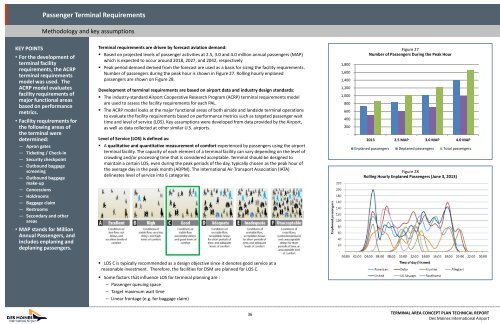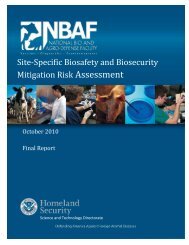DSM Terminal-Area-Concept-Plan-Technical-Report - FINAL
DSM Terminal-Area-Concept-Plan-Technical-Report - FINAL
DSM Terminal-Area-Concept-Plan-Technical-Report - FINAL
You also want an ePaper? Increase the reach of your titles
YUMPU automatically turns print PDFs into web optimized ePapers that Google loves.
Passenger <strong>Terminal</strong> Requirements<br />
Methodology and key assumptions<br />
KEY POINTS<br />
• For the development of<br />
terminal facility<br />
requirements, the ACRP<br />
terminal requirements<br />
model was used. The<br />
ACRP model evaluates<br />
facility requirements of<br />
major functional areas<br />
based on performance<br />
metrics.<br />
• Facility requirements for<br />
the following areas of<br />
the terminal were<br />
determined:<br />
— Apron gates<br />
— Ticketing / Check-in<br />
— Security checkpoint<br />
— Outbound baggage<br />
screening<br />
— Outbound baggage<br />
make-up<br />
— Concessions<br />
— Holdrooms<br />
— Baggage claim<br />
— Restrooms<br />
— Secondary and other<br />
areas<br />
<strong>Terminal</strong> requirements are driven by forecast aviation demand:<br />
• Based on projected levels of passenger activities at 2.5, 3.0 and 4.0 million annual passengers (MAP)<br />
which is expected to occur around 2018, 2027, and 2042, respectively<br />
• Peak period demand derived from the forecast are used as a basis for sizing the facility requirements.<br />
Number of passengers during the peak hour is shown in Figure 27. Rolling hourly enplaned<br />
passengers are shown on Figure 28.<br />
Development of terminal requirements are based on airport data and industry design standards:<br />
• The industry-standard Airport Cooperative Research Program (ACRP) terminal requirements model<br />
are used to assess the facility requirements for each PAL.<br />
• The ACRP model looks at the major functional areas of both airside and landside terminal operations<br />
to evaluate the facility requirements based on performance metrics such as targeted passenger wait<br />
time and level of service (LOS). Key assumptions were developed from data provided by the Airport,<br />
as well as data collected at other similar U.S. airports.<br />
Level of Service (LOS) is defined as:<br />
• A qualitative and quantitative measurement of comfort experienced by passengers using the airport<br />
terminal facility. The capacity of each element of a terminal facility can vary depending on the level of<br />
crowding and/or processing time that is considered acceptable. <strong>Terminal</strong> should be designed to<br />
maintain a certain LOS, even during the peak periods of the day, typically chosen as the peak hour of<br />
the average day in the peak month (ADPM). The International Air Transport Association (IATA)<br />
delineates level of service into 6 categories:<br />
1,800<br />
1,600<br />
1,400<br />
1,200<br />
1,000<br />
800<br />
600<br />
400<br />
200<br />
-<br />
Figure 27<br />
Number of Passengers During the Peak Hour<br />
2013 2.5 MAP 3.0 MAP 4.0 MAP<br />
Enplaned passengers Deplaned passengers Total passengers<br />
Figure 28<br />
Rolling Hourly Enplaned Passengers (June 3, 2013)<br />
• MAP stands for Million<br />
Annual Passengers, and<br />
includes enplaning and<br />
deplaning passengers.<br />
• LOS C is typically recommended as a design objective since it denotes good service at a<br />
reasonable investment. Therefore, the facilities for <strong>DSM</strong> are planned for LOS C.<br />
• Some factors that influence LOS for terminal planning are :<br />
– Passenger queuing space<br />
– Target maximum wait time<br />
– Linear frontage (e.g. for baggage claim)<br />
36<br />
TERMINAL AREA CONCEPT PLAN TECHNICAL REPORT<br />
Des Moines International Airport




